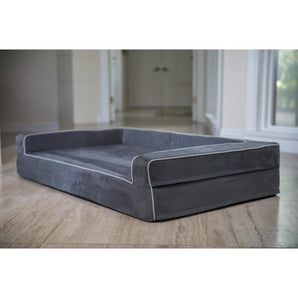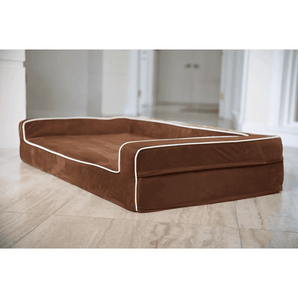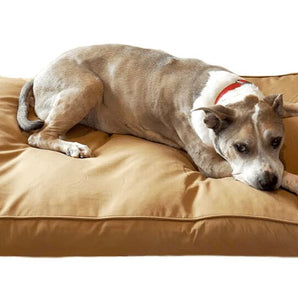If you’re a dog owner, you know your pup deserves the very best—and that includes their crate. Whether you’re bringing home a young puppy or managing the needs of a fully-grown giant breed, the right size crate can make all the difference when it comes to their comfort, safety, and happiness.
Think of it like this: a crate is your dog’s home within your home. It’s their spot to relax, sleep, and feel secure. But the perfect crate size? That’s where many dog owners struggle. If your dog doesn't have enough space, they won’t lie down comfortably. Too much space? Your dog may end up having accidents, especially if you're using it for potty training.
We'll help you find the right dog crate size for your furry friend’s needs—because when it comes to your dog’s safety and comfort, there’s no room for guesswork.
Why Dog Crate Size Matters
Choosing the right dog crate size can affect your dog’s comfort, crate training success, and overall behavior.
Comfort
Your dog should be able to stand, turn around, and lie down comfortably in their crate. If the crate is too small, they’ll feel cramped and stressed. On the other hand, too much space can make it hard for them to settle in—especially during crate training. Dogs are den animals by nature, and a well-fitted crate mimics that cozy, secure feeling they naturally seek.
Crate Training
Helping your dog see their crate as a safe, positive place can go a long way toward proper crate training. If the crate size isn’t correct, training can backfire. A crate that’s too big can invite accidents—especially during potty training. The goal is to make it comfortable but not excessive, so your pup learns to hold it when necessary.
Behavior Issues
A properly sized crate can also reduce anxiety and destructive behaviors. An anxious dog may feel safer in a smaller, more enclosed space where they can relax without distractions. On the other hand, too much open room might leave them pacing or restless.
How to Measure Your Dog for the Right Crate Size
Before you hit ‘add to cart,' you need to get your dog’s measurements. Here’s a step-by-step guide to finding the best crate based on your dog's size:
- Measure Your Dog’s Length: Have your pup stand up straight and measure from the tip of their nose to the base of their tail.
- Measure Your Dog’s Height: From the top of their head (or ears, if they’re perky) to the ground.
- Add a Few Inches: Add 2-4 inches to both the length and height measurements. This ensures they can stand, turn, and lie down comfortably without being squished.
A crate that allows just the right amount of space will make your dog comfortable without feeling too big. And remember—puppies grow fast! If you’re buying for a young pup, consider an adjustable crate with dividers so you can adjust it as your puppy grows.
Finding The Right Type of Dog Crate
The best crate for your dog also depends on your dog's breed, size, and behavior. When shopping around, you'll mostly find soft-sided crates that are smaller and great for travel, or wire or plastic crates that are larger and meant to be a more permanent fixture in your home.
Soft-Sided Crates
Soft crates are great for small to medium-sized dogs and ideal for travel or short-term use. They’re lightweight, easy to carry, and comfy for pups who like to snooze on the go. However, they’re not the best choice for chewers or dogs who get anxious in confined spaces.
Wire and Plastic Crates
- Wire Dog Crates: These are versatile, breathable, and easy to clean. Wire crates work well for house training and can be adjusted for growing puppies with dividers. They also provide plenty of ventilation for large dogs or breeds with thick coats.
- Plastic Dog Crates: Sturdy and enclosed, plastic crates are perfect for travel and for dogs who feel calmer in a more private space. They’re also great for pups who tend to escape from wire crates.
Choosing the Right Crate Based on Dog Behavior
Your dog’s behavior also plays a big role in crate selection. Here are a few tips to help you choose the best option:
- For Potty Training or House Training: Choose a crate that allows your dog to stand, turn, and lie down comfortably without giving them too much space. A crate that’s too big might encourage your dog to go potty in one corner and sleep in the other. Crate training during housebreaking works best when the crate mimics a small, clean den—a natural instinct for dogs.
- For Anxious Dogs: A more enclosed crate, like a plastic dog crate, can help nervous dogs feel secure. Too much open space might overstimulate them, leaving them uneasy. If your adult dog gets anxious from external noise, light, or movement, the cozy, cave-like feel of an enclosed crate can make a big difference.
- For Active, Curious Dogs: A wire crate with plenty of ventilation and visibility will help them feel included without roaming freely. These dogs often want to see what’s happening around them, so wire crates are great for providing a balance of structure and openness. If your curious pup tries to escape or chew, look for wire crates with reinforced doors or locks.
- For Chewers or Escape Artists: Some dogs see their crate as a challenge, and if they’re big chewers or escape artists, you’ll want a sturdier option. Metal dog crates are your best bet here—they’re durable, escape-proof, and can handle rougher behavior without breaking down.
- For Puppies: Growing puppies benefit from adjustable crates with dividers. These allow you to create a smaller space for potty training and expand the area as they grow. Puppies also tend to chew, so choosing a crate with durable materials is key.
Other Things to Keep In Mind
In addition to dog crate size, don’t overlook these additional details:
- Durable Materials: Look for crates made of high-quality, sturdy materials—especially if you have a large breed or a young puppy who loves to chew. A durable crate ensures long-lasting use and keeps even the most rambunctious dogs secure.
- Portability: If you travel frequently with your pup, consider how easy it is to move and set up the crate. Some crates fold down for portability, while others are specifically designed for car or plane travel. Soft-sided crates are lightweight and easy to carry, while sturdy plastic crates offer added security on the go.
- Proper Ventilation: Good airflow is key, especially for larger breeds or dogs with thick coats. Wire crates and well-ventilated plastic crates help ensure your dog stays cool and comfortable, even in warmer weather.
- Ease of Cleaning: Dogs can be messy, especially puppies in the middle of house training. Look for crates with removable trays or surfaces that are easy to wipe clean. This will save you time and keep your pup’s space hygienic.
Making Your Dog's Crate Comfortable
Once you’ve chosen the right crate for your pup, you want to make it a cozy and welcoming space. A crate that feels inviting will encourage most dogs to settle in and relax—an important step in successful crate training.
- Add a Crate Pad or Blanket: The crate floor can feel hard and uncomfortable, especially for large dogs. Adding a crate pad or a soft blanket will make the space much cozier. Choose a pad that fits your dog's size and provides enough support, especially for older pups or breeds prone to joint issues. For destructive chewers, go for a chew-proof crate pad.
- Include Their Favorite Toy: Placing a familiar toy in the crate can help ease anxiety and give your pup something to do while they settle. Puzzle toys or chew toys are great for keeping active dogs entertained and can reduce restlessness.
- Cover the Crate: For anxious dogs, draping a blanket or crate cover over the top can create a more den-like environment that feels safe and calming. Make sure there’s still adequate ventilation, so your dog stays comfortable.
- Consider Temperature: Think about the climate and location of the crate. If it’s cold, add an extra blanket for warmth. If it’s warm, ensure proper ventilation and airflow so your pup doesn’t overheat.
When your dog starts to associate their crate with comfort and relaxation, it becomes a positive place they enjoy spending time in—whether it’s for resting, crate training, or travel.
"What Size Crate For My Dog?" Find The Right Fit!

At the end of the day, finding the right dog crate size is all about making sure your dog feels comfortable, secure, and safe. Take the time to measure your dog’s height and length, factor in their behavior, and consider their breed and needs. A crate that’s the perfect size will keep your dog comfortable and happy—and give you peace of mind knowing they’re safe and secure.





